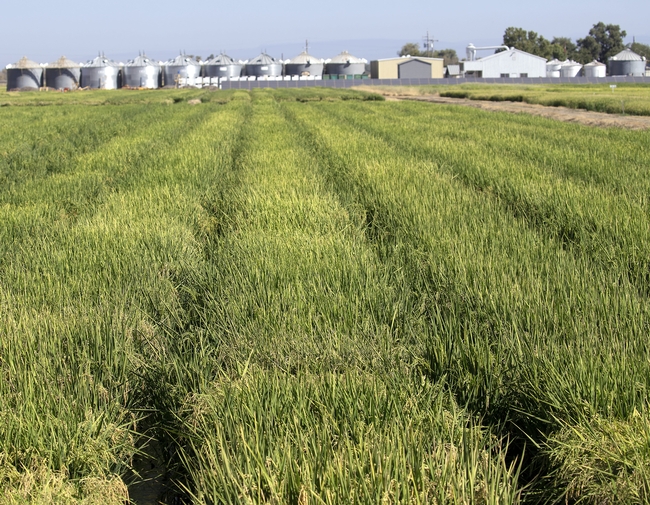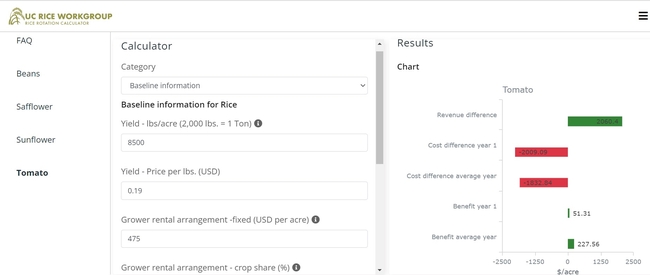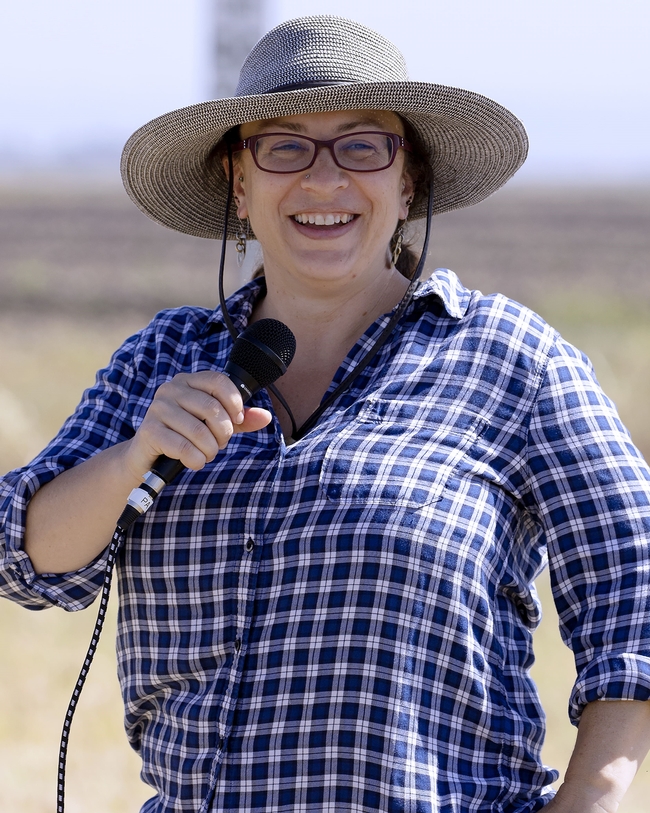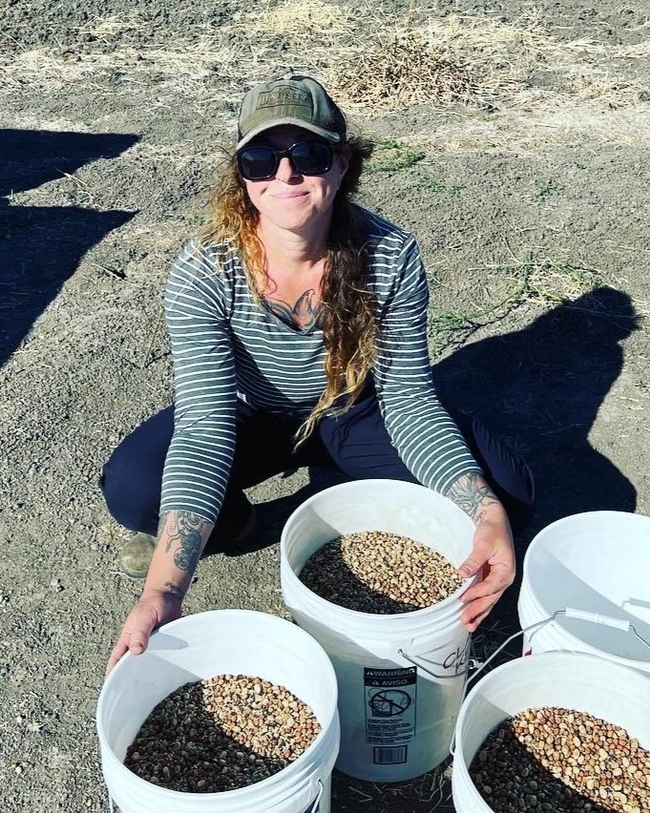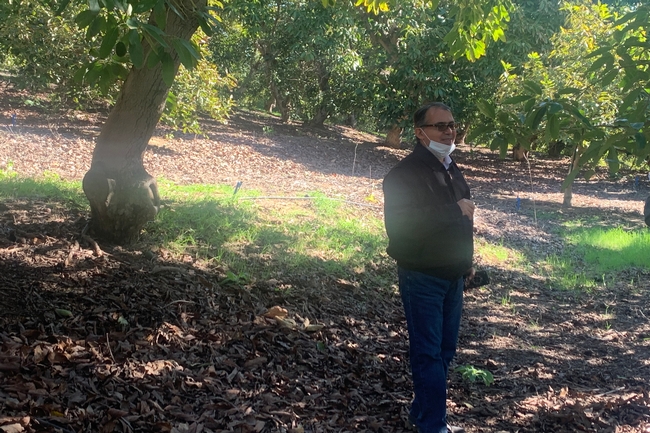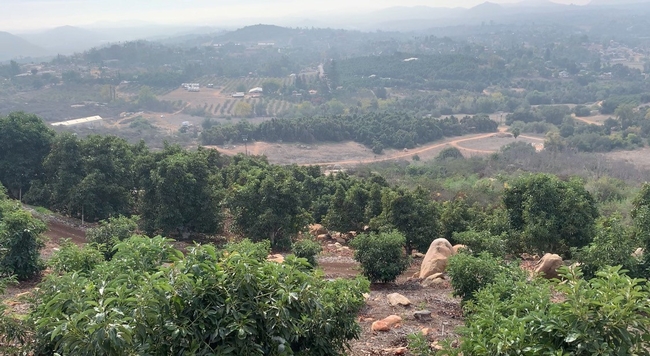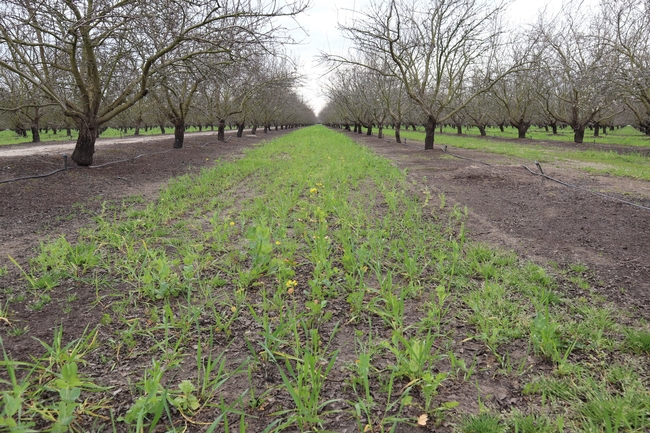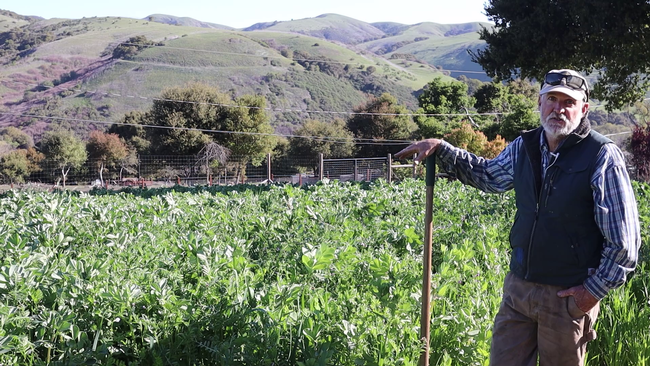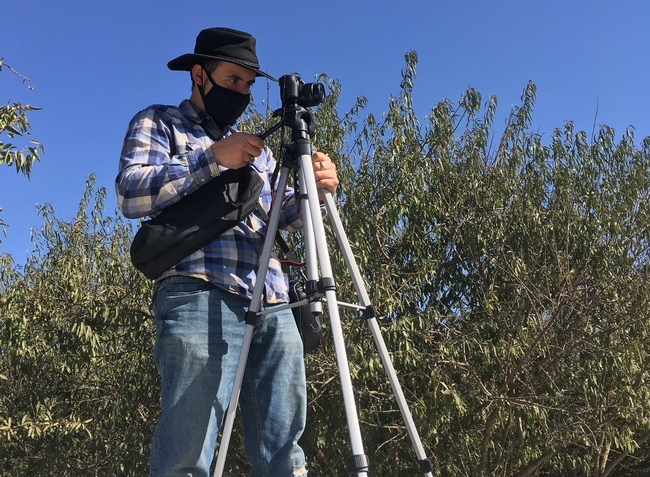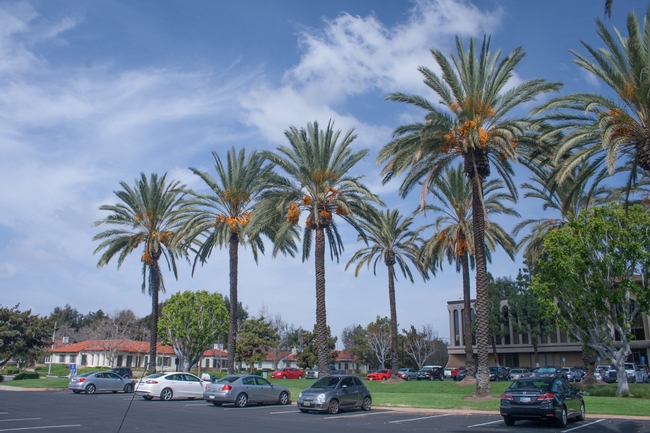Posts Tagged: crop
New tool calculates crop rotation costs, benefits for California rice growers
UC researchers studying how practice can help farmers manage drought, pests, other challenges
Due to severe water shortages, rice acres planted in California plummeted by 37% from 2021 to 2022, according to numbers released recently by the U.S. Department of Agriculture's National Agricultural Statistics Service. But now, thanks to University of California researchers, growers have a new tool they could potentially use to cope with droughts and other environmental and socioeconomic changes.
A crop rotation calculator provides farmers in the Sacramento Valley – where 97% of California rice is grown – with projections on the economic impacts of transitioning their fields from rice into four less water-intensive crops: dry beans, safflower, sunflower or tomato.
The tool represents an initial attempt to address the dearth of research on rice crop rotation in California, while giving growers much-needed, science-backed data on whether the practice would make financial sense for their farms.
“I believe more rice growers could benefit from the many advantages of crop rotation, and this new tool is an excellent first step by the UC to help growers look into making such a transition,” said George Tibbitts, a Colusa County rice farmer.
Funded in part by the USDA National Institute of Food and Agriculture, through the Western Integrated Pest Management Center, the calculator is a collaborative effort of UC Agriculture and Natural Resources, UC Integrated Pest Management and UC Davis to fill a major gap in rice research.
“I do think there are people who would have tried rotational crops in the past, but it's just so unknown, we didn't have anything we could give them and be like, ‘Hey, this is the recommended crop for your area,'” said Whitney Brim-DeForest, UC Cooperative Extension rice advisor. “This tool gives them some preliminary data they can use to make a more informed decision.”
Crop rotation a potential boon to growers, environment
UC Davis doctoral student Sara Rosenberg and Brim-DeForest, alongside other members of the UC rice research team, surveyed California rice growers in 2020 on their experiences with and perceptions of crop rotation. Although the practice is rare in the Sacramento Valley (only an estimated 10% of rice acreage is under rotation), some farmers reported benefits that could be crucial in a water-scarce future.
“From having conversations with growers who do rotate, one of the biggest benefits they describe is their flexibility in times of drought, where they can keep producing on their land when there isn't enough water to grow rice,” said Rosenberg, noting that crop rotation could be one option in a “toolbox” of strategies that growers also use to manage fertilizer price shocks, herbicide resistance and other challenges.
During the ongoing drought that caused about half of California's rice acreage to go fallow in 2022, Tibbitts said his water district was only able to allocate 10% of his usual allotment.
“With such a limited supply, it would have been tough to grow even one field of rice,” he said. “But it was enough water so that we could rent two of our fields to a tomato grower – tomatoes under drip irrigation use much less water than a flooded field of rice. We were also able to grow one field of sunflowers, which doesn't need any irrigation at all if you can plant the seeds into existing moisture in the early spring.”
While drought is one motivating factor to rotate crops, Tibbitts said that on principle he avoids planting all his acreage in rice and “not have all (his) eggs in one basket.”
“My primary motivation for rotating into and out of rice has been to help with weed and disease control,” he added. “Crop rotation is a primary tool of IPM (integrated pest management), and I feel it has helped me greatly over the years.”
According to Brim-DeForest, rotating cropping systems can allow for the use of different weed control tools, such as different herbicide modes of action, and different cultural controls such as tillage, reducing the chances of selecting for herbicide-resistant weeds – an increasingly pervasive issue in rice systems.
Rosenberg noted that, in some situations – and depending on the crops in rotation – the practice can also disrupt the life cycles of insects and diseases and potentially improve soil structure and increase nutrient cycling and uptake, which may lead to a reduction in inputs such as fertilizer.
More research on crop diversification needed in rice systems
The benefits of crop rotation for California rice growers are largely theoretical and anecdotal, however, so the UC rice team is looking to add evidence-based grounding through a variety of studies – from looking at long-term effects on soil health indicators to testing various cover crops (which may deliver some benefits of diversification, similar to those of rotation).
“In California, there is no quantitative data on crop rotation in rice,” said Brim-DeForest. “You'd think after a hundred and some odd years (of UC agricultural research), all the research would have been done, but, no – there's tons still to do.”
Through interviews with Sacramento Valley growers, researchers found that cost was frequently mentioned as a barrier to trying crop rotation, along with incompatible soil conditions and a lack of equipment, knowledge and experience.
To help clarify those economic uncertainties, the new calculator tool allows growers to enter baseline information specific to their circumstances – whether they rent or own their own land, whether they contract out the work to plant the rotational crop, and other factors. The calculator then generates potential costs and benefits of staying in rice versus rotating to dry beans, safflower, sunflower or tomato, during the first year and in an “average” year for those crops.
The upfront costs of rotation during “year one” can be daunting. Therefore, the tool only focuses on a short-term profitability perspective. Researchers are currently working on longer term modeling for crop rotation – incorporating the possibility of reduced herbicide use over time, and under different crop yield scenarios, for example – that could significantly change the growers' calculus.
“You could actually be profitable in the long term, whereas this first, short glimpse is showing you a negative,” said Rosenberg.
In addition, thanks to collaboration with the UC IPM team, the rice rotation calculator is an evolving tool that will be continually improved based on user feedback and additional data. Brim-DeForest also said that it could be adapted to other cropping systems – for example, alfalfa going into another rotational crop.
The rice calculator tool can be found at: https://rice-rotation-calculator.ipm.ucanr.edu/.
Other contributors to the project include Bruce Linquist, Luis Espino, Ellen Bruno, Kassim Al-Khatib and Michelle Leinfelder-Miles of UCCE; Cameron Pittelkow of UC Davis; as well as UC IPM team members Chinh Lam, Tunyalee Martin and Hanna Zorlu; and the California rice growers and industry members who participated in the research.
Avocado growers to get irrigation tools, strategies from UC ANR’s Montazar
CDFA grant supports research to optimize water use for iconic California crop
California growers, who account for more than 90% of avocado production in the U.S., will soon be getting some help in weathering the extreme fluctuations of climate change.
Ali Montazar, a University of California Cooperative Extension irrigation and water management advisor, recently received a grant to develop tools and strategies that optimize growers' irrigation practices across Southern California – the state's avocado belt. California avocados are valued at more than $411 million, according to the National Agricultural Statistics Service.
“This region faces uncertain water supplies, mandatory reductions of water use, and the rising cost of water – while efficient use of irrigation water is one of the highest conservation priorities,” Montazar said. “Water is the most critically important input to avocado production.”
At the California Avocado Commission's suggestion, Orange County was added to the study to better capture the range of climates and cropping systems across the region, Montazar said.
He hopes to develop “crop coefficients” that avocado growers can use to determine the optimal irrigation for their crop based on a host of factors: soil type and salinity, canopy features, row orientation, slopes, soil and water management practices, and more.
“Growers are unclear on how much water the crop actually needs under those conditions,” Montazar said.
He will incorporate data from the actual water use in the experimental orchards – including information from the newest soil moisture and canopy temperature sensors – to help ensure growers do not under- or overwater their crops. Overirrigating contributes to a devastating disease, avocado root rot, caused by the plant pathogen Phytophthora cinnamomi.
Another component of the grant supports outreach in disseminating these resources and best practices to the broader agricultural community.
“Developing and adopting these tools and information may have a significant impact on water quality and quantity issues and bolster the economic sustainability of avocado production not only in the well-established production region of Southern California, but also in Kern and Tulare counties where new avocado plantings are growing,” Montazar said.
Preliminary findings and recommendations are expected at the end of 2022.
Cover cropping season has begun: Free recorded webinars, demos available
Cover crops, typically planted in early fall, deliver a host of agricultural and conservation benefits. But many growers have gone away from planting them due to technical challenges and extra costs associated with the practice. In partnership with the Contra Costa County Resource Conservation District, two University of California Cooperative Extension advisors collaborated to support farmers' cover cropping efforts and reduce costs.
Kamyar Aram, UCCE specialty crops advisor for Contra Costa and Alameda counties, and Rob Bennaton, UCCE Bay Area urban agriculture and food systems advisor, developed online project content for a free educational series on cover cropping, which entails growing non-cash crops to add beneficial biomass to soils.
The series – comprising 10 webinars and five virtual farm-site visits – features UC farm and urban agriculture advisors and some of California's foremost experts on cover cropping. It helps growers overcome their hesitations about the practice, which provides benefits such as alleviating compaction, improving water retention and increasing organic matter and nutrients in the soil.
“Our site visit videos include a diversity of cropping systems, operation types and scales, and levels of experience with cover crops, so we really capture a variety of perspectives,” Aram said. “Now, with the videos online, I hope that they will serve as tools for other farm educators, as well as a resource for growers directly.”
When the COVID-19 pandemic scrapped plans for in-person workshops and visits, the series organizers pivoted to online webinars, starting in fall 2020, which drew more than 150 participants. The recorded videos – which cover basic methods, financial assistance, tips for orchards and vineyards and more – expanded the potential reach and impact of the series far beyond Contra Costa County.
“Each video, whether it's a webinar recording or a virtual site visit, emphasizes different aspects, and the titles are designed to help viewers find the resources they are most likely to benefit from,” said Aram. “There really is something for everyone.”
In particular, the organizers of the series recognized the importance of including technical and extension support to urban and semi-urban farmers in the East Bay and beyond.
“We wanted to make sure to include practical support from fellow farmers that was both accessible and relevant to our diverse small and urban farmers,” said Julio Contreras, UCCE community education specialist. “This meant covering topics like seeding with spreaders or by broadcasting – using small equipment and machinery or no-till systems – and even cover cropping in planter boxes.”
Aram and Bennaton also credited their Contra Costa Resource Conservation District partners: Ben Weise, agriculture conservation manager; Derek Emmons, agriculture conservation coordinator; and Chris Lim, executive director.
The project, funded by a Specialty Crops Block Grant from the California Department of Food and Agriculture, was also made possible by the generous contributions of time and expertise from presenters and hosts of farm-site visits, according to Aram.
“I hope that the videos will enjoy a long life online; they really contain a wealth of knowledge,” he said.
The series is available for view at http://ucanr.edu/CoverCropsCoCo.
Ornamental landscape date palm: An overlooked urban fruit tree
One fruit, though, is not on the radar of foodies and foragers. Yet it's crunchy, sweet, flavorful, often seedless, and very common in Southern California landscapes. It's the fruit of the date palm, rarely thought of as a food source in our urban environment, more frequently viewed as a nuisance because dates fall off trees, where they create litter that must be cleaned up.
Unfortunately, coastal Southern California lacks the high sustained heat and aridity for proper fruit maturation and curing to produce traditional soft-ripe dates of good eating quality. The dates that fall from the trees have been unattractive to gather for sale and consumption, processes that could help to resolve the fruit litter problem in the landscape.
However, some varieties of dates can be eaten at a less than a mature state, traditionally called “khalal.” Fruit in the khalal stage have attained their maximum size, are typically yellow or red, have a sweet flavor, and are crunchy, somewhat like an apple. Several date varieties, like ‘Barhee,' are sometimes sold and eaten in the khalal stage. Fortunately, from a food standpoint (or unfortunately if you are a landscape manager), date fruits do mature to the khalal stage in coastal Southern California because high sustained heat and aridity are not required to attain this stage of development.
While ‘Barhee' is not too common as a landscape subject, another variety, ‘Zahidi,' is common and typically produces abundant fruits in coastal Southern California. These golden yellow fruits are conspicuous and showy in the khalal stage, are typically on the palm for several months from late fall to spring, and are really good to eat. Also, in many cases, these fruits are seedless! (Note to horticulture geeks: date palms are dioecious - separate male and female trees - and because nearly all edible date palms in the landscape are female, their flowers were pollinated by other species of landscape Phoenix. The resulting hybrid fruits are seedless, or pollination is not required for fruit to set and develop - parthenocarpy.)
Urban foragers looking for their next food adventure, or even a potential enterprise, might want to consider taking advantage of this otherwise nuisance and unwanted fruit. Khalal fruit can be gathered from the ground and cleaned. But it is best to collect them off the palm. Cutting an inflorescence (entire fruit stalk) and lowering it carefully to the ground would be ideal.

Khalal-stage fruits of the date variety ‘Zahidi’ are really good to eat: crunchy, sweet, and flavorful. Also, they are seedless (D. R. Hodel).


